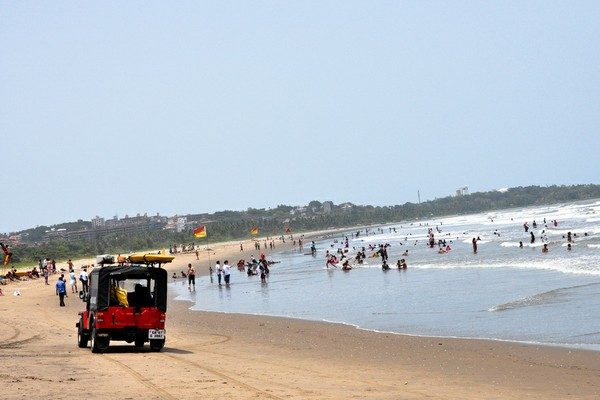Located in the capital city of Panjim, lies the extremely famous and much visited Miramar beach. It lies about 3 kilometers away from the Panjim city center and is a hotspot for locals and tourists to visit.
The beach used to be much cleaner a long time ago. There were also some pretty benches to sit on facing the beach, along its perimeter. Those are long gone now as is the wall that used to keep the sand from getting onto the road and creating a nuisance to traffic.
History of Miramar
Just a handful of people are aware that the original name of Miramar beach was “Porta de Gaspar Dias”. And even less know about the existence of a now extinct fort, which played a major role during the initial part of the Portuguese regime. The canon, found near Dempo college, and presently displayed at the rotunda at Miramar, is the only vestige of its existence, in its original place.
Five centuries ago, when the tentacles of the Portuguese Empire, touched the shore of Kerala, it was an accepted fact in their endeavor, they consolidated themselves on the western coast, with Goa as their entreport, and wrenched the power from the Adilshah of Bijapur. They lent a helping hand to the various religious orders to erect imposing churches & convents in the city of Old Goa, the then hub of activity and the capital city of the Adilshahi empire. Simultaneously they tried to secure the city of Goa by fortifying it all around, to avoid the impending dangers from the neighboring province, as well as the threat from the enemy ships.
The only defense, then erected on river Mandovi, was the fortress of Reis Magos, which was called FORTE REAL (Royal Fortress). This fort was constructed by Viceroy Dom Afonso de Noronha in 1551-54. The mouth of the river was very narrow, and the present width is the consequence of erosion and sandbars.
At this point in time, Panaji or Panjim was sparsely populated, the only significant building being Adil Shah’s palace. All vigil on the river was conducted from here. Believing that there was a very real threat of invasion by the Dutch, the king of Portugal ordered the city to be fortified. This brought about the construction of Fort Gaspar Dias.
History of Fort Gaspar Dias
Construction began in 1598, during the governorship of Viceroy Dom Francisco de Gama, Count of Vidigueira and the great-grandson of Vasco da Gama. The fort was named “FORTE DA PONTE DE GASPAR DIAS”. While there are no more structural remains of the fort today, people have made assumptions as to where it lay and how far it spread.
According to some, it spread across the entire Miramar circle, encompassing the present resident of Damodar Mangalji, Clube Gaspar Dias, both Dhempe and the M.S. College of Law and extended right up to the junction where the Agricultural department has offices.
Living in constant fear of an attack by Sambhaji, in 1683, the Portuguese shifted their attention to protecting the mainland. Mormugao was vetoed as the new capital.
In 1774, the Marques de Pombal ordered Governor Filipe de Valadares Souto Maior to demolish Fort Gaspar Dias but this never happened. On the 6th of September 1799, 6 English ships landed at Aguada, disembarked and proceeded to occupy the forts at Aguada, Gaspar Dias, Cabo, and Mormugao. They were there for almost 15 years up to 1814 and when they did leave, all 4 forts were considerably damaged.
Fort Gaspar Dias’ Final Years
On 10th February 1835, during the Civil War days of Prefecture, the First Regiment of Infantry and the Artillery Battalion which were stationed in Panjim, made a counter-revolutionary movement. This rebellion was quashed and the Fortress put to flames. Seven years later, the Fortress was restored and partly reconstructed in 1842.
A committee created by an Order dated 4th February 1869, suggested that the Gaspar Dias Fort was not of battle use and that the same could be converted into sanitary quarters for convalescing military personnel. And so served as a sanitarium in 1878.
Not much is known about Fort Gaspar Dias in its later years and so it fell into ruins. Ultimately it was razed to the ground to make way for development works for the road to Dona Paula.
(Source – Clube Gaspar Dias website)
Miramar Today
Today, Miramar beach is a much visited and popular beach with domestic tourists visiting Goa. It’s not the safest beach to swim at since it’s at the mouth of the river Mandovi and there are always strong currents. It’s not the cleanest beach so one needs to be extra careful if they choose to step onto the sand. People, mostly locals, do use the beach for evening walks and exercise as well since it stretches right up to the end where it is also known as Caranzalem beach.
The beach is often used for outdoor events like volleyball tournaments, a kite festival that is held every year usually in summer and the like. Movie screenings are also held, especially at the time of the International Film Festival of India which happens in November.
Miramar beach is surrounded by eating joints from hotels to restaurants to street food. The bhel puri and sev puri are a hit with pretty much everyone and it’s almost impossible to get parking close to the stalls. So if you’re ever at Miramar, go ahead and try out the bhel puri. It’s really good, I assure you.
ItsGoa/OCT/KDGP


